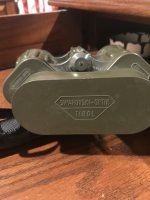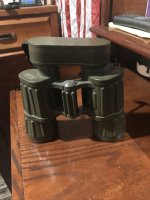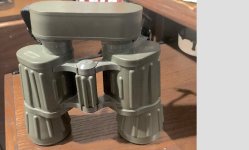Hi Ron,
Swarovski has been making this style of binocular continuously since 1948!
Though with various updates to the lens coatings, and making later production waterproof.
In all there’s been around 3/4 million of the various models made over the 75 years!
(see posts #4 and 5 at:
Changes to 7x42 Traditional / Habicht Porro )
Yours is the IF RA version:
IF indicates individual focus eyepieces (as opposed to CF/ centre focus, where both eyepieces are focused by a central wheel).
And RA indicates the rubber armoured covering, as opposed to the alternative leatherette one.
In 1984 the design was modified to make it waterproof, and it can be easily distinguished by the valve cap screws on the front bridge arms.
Interestingly, the earliest production had the same narrow arms as the previous version, which yours has.
So it can be precisely dated to 1984:
View attachment 1516260
Yours has the dual layer lens coating typical to Swarovski's of the era, which makes for an adequately bright image
though with a yellow tint under normal viewing conditions. However, as light levels decrease, the yellowness ceases to be noticeable.
Understandably, later models have improved coatings that give a brighter and more neutral image.
Generally for birding a CF model is preferred, as it gives the ability to rapidly refocus to different distances.
And many find 10x too powerful for easy steady use, preferring 8x.
. . . But as with most things, individual preferences may vary considerably.
John











